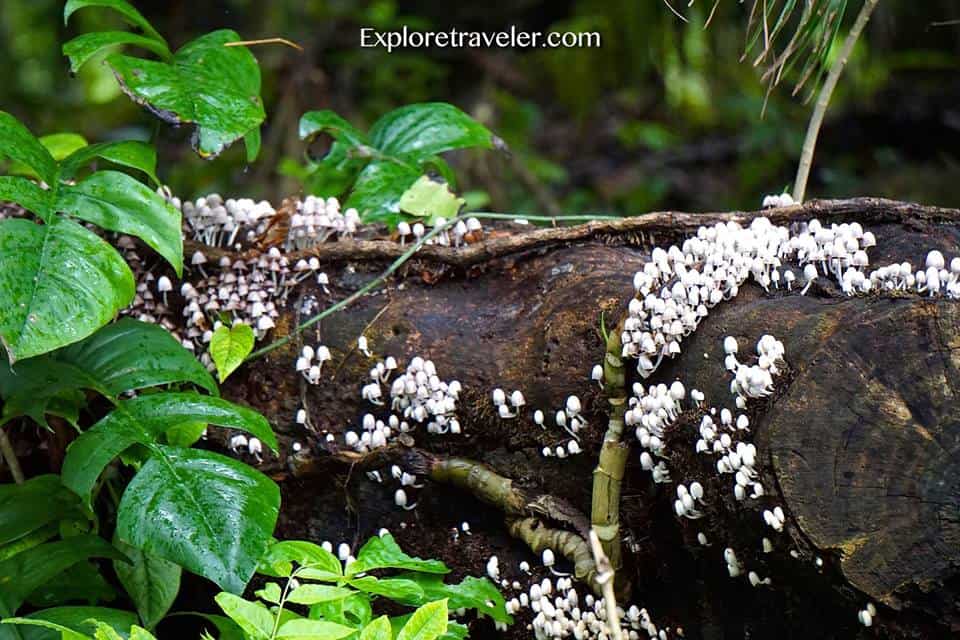Frequently Asked Questions
How many mushrooms are poisonous?
The exact number of poisonous mushrooms is uncertain due to variations in species and regions. It is crucial to be cautious and knowledgeable about mushroom identification before consuming them.Consult experts or resources for accurate information on identifying poisonous mushrooms.
How many edible types of mushrooms are there?
There are over 2,000 types of mushrooms that are considered edible, including popular varieties like button mushrooms, shiitake, portobello, and more. It is important to properly identify mushrooms before consuming them to avoid any potential risks.
Which kind of mushrooms are edible?
Edible mushrooms include varieties like button mushrooms, cremini mushrooms, shiitake mushrooms, oyster mushrooms, and more. It's crucial to accurately identify mushrooms before consuming them to avoid ingesting toxic varieties that can lead to severe health issues. Consult with a knowledgeable expert if uncertain about mushroom identification.
Where to buy enoki mushrooms in the Philippines?
Enoki mushrooms can be purchased in the Philippines at major supermarkets, specialty grocery stores, and online marketplaces. Check out local wet markets for a fresh supply. Explore organic shops or health food stores for high-quality options. Shopping online offers convenience and access to a wider selection of enoki mushrooms from various suppliers.
How to start a mushroom farm in the Philippines?
Starting a mushroom farm in the Philippines involves first researching suitable locations, acquiring the necessary supplies and equipment, and obtaining training in mushroom cultivation. Next, prepare a suitable growing area, source quality mushroom spores or spawn, and follow proper cultivation techniques for successful harvests. Marketing and selling the mushrooms locally or to businesses is key for profitability. Networking with other mushroom farmers can also provide valuable insights and support in this venture.
Where to buy mushroom spawn in the Philippines?
In the Philippines, mushroom spawn can be purchased from agricultural supply stores, online retailers, or directly from mushroom farmers. Local markets and agricultural cooperatives also often offer mushroom spawn for sale. It is advisable to inquire with local agricultural organizations for specific recommendations and sources within the Philippines.
What mushrooms are edible in the wild?
It is crucial to have expert knowledge when foraging for wild mushrooms. Seek guidance from local foraging groups or experienced mycologists to identify edible varieties correctly. Common edible wild mushrooms include chanterelles, morels, porcini, and oyster mushrooms, but never consume any mushroom without absolute certainty of its safety.
How to raise mushrooms in the Philippines?
To raise mushrooms in the Philippines, you can start by preparing a suitable growing space with controlled temperature and humidity. Choose the right mushroom variety, such as oyster or shiitake. Use high-quality mushroom spawn and substrate for cultivation. Regularly monitor and maintain the growing conditions for successful mushroom production.
What edible mushrooms grow in the Philippines?
There are several edible mushrooms that grow in the Philippines, including the delectable oyster mushroom, the flavorful shiitake mushroom, and the meaty straw mushroom. These varieties offer diverse tastes and textures, making them popular choices for culinary dishes in the region.
Where are poisonous mushrooms found?
Poisonous mushrooms are typically found in forests, woodlands, or areas with decaying organic matter. They can also grow near trees, in damp environments, or on dead or decaying wood. It's crucial to be cautious and knowledgeable when foraging for mushrooms to avoid consuming any toxic varieties.
Can edible mushrooms become poisonous?
Yes, edible mushrooms can become poisonous if they are misidentified or improperly prepared. It is crucial to accurately identify and cook mushrooms to avoid ingesting toxic varieties, as some edible species have poisonous lookalikes that can lead to serious illness or even death.
How to grow shiitake mushrooms in the Philippines?
To grow shiitake mushrooms in the Philippines, you can start by preparing a suitable substrate like sawdust or logs. Inoculate the substrate with shiitake mushroom spawn, maintain proper moisture and temperature conditions, and harvest the mushrooms when they reach maturity. Proper sanitation and monitoring are crucial for successful cultivation.
How many types of edible mushrooms are there?
There are numerous types of edible mushrooms, including common varieties like button, portobello, shiitake, and oyster mushrooms. Each type offers unique flavors and textures, making them versatile ingredients in various culinary dishes. Be cautious with mushroom identification for foraging.
Where to buy mushroom seeds in the Philippines?
You can buy mushroom seeds in the Philippines from reputable agricultural supply stores, online seed shops, or directly from mushroom farms. Be sure to verify the quality and authenticity of the seeds before making a purchase to ensure successful cultivation.
How to plant mushrooms in the Philippines?
To plant mushrooms in the Philippines, prepare a shaded, well-draining area with proper ventilation. Inoculate mushroom spores into a substrate, maintain optimal humidity and temperature levels, and ensure proper sanitation practices. Harvest when mature, and repeat the process for continuous mushroom cultivation.
Are mushrooms in high demand?
Mushrooms are experiencing a surge in popularity and demand due to their versatility in cuisine, nutritional benefits, and potential medicinal properties. The increasing interest in plant-based diets and sustainable food sources has also contributed to the high demand for mushrooms.
Where to sell mushrooms in the Philippines?
In the Philippines, you can sell mushrooms at local markets, grocery stores, restaurants, and through online platforms. Partnering with distributors or joining agricultural cooperatives can also help in selling mushrooms to a wider audience. Networking with chefs and food enthusiasts can create additional selling opportunities.
What part of a mushroom is poisonous?
The most poisonous part of a mushroom is typically the cap and stem, which contain the highest concentration of toxins. It is crucial to accurately identify mushrooms before consumption to avoid ingesting any harmful varieties that could lead to serious health issues.
Are there any poisonous mushrooms?
Yes, there are poisonous mushrooms that can cause harm if ingested. It is crucial to be knowledgeable about identifying safe mushrooms before consuming any wild mushrooms to avoid potential health risks. Consulting with an expert or using guides can help in distinguishing between edible and toxic varieties.
Do mushrooms grow in the Philippines?
Yes, mushrooms can be found growing in the Philippines. With a favorable tropical climate and suitable growing conditions, various types of mushrooms thrive in different regions of the country. From button mushrooms to more exotic varieties like oyster and shiitake, the Philippines offers a diverse range of mushroom cultivation possibilities for enthusiasts and farmers alike.
What percentage of mushrooms are edible?
Determining the percentage of edible mushrooms requires expertise due to the vast variety of species. While some are safe to eat, others are toxic. Seek guidance from a knowledgeable source like a mycologist before consuming any wild mushrooms.
What fungi are native to the Philippines?
Native fungi in the Philippines include Ganoderma lucidum (reishi mushroom), Lentinula edodes (shiitake mushroom), Auricularia polytricha (wood ear mushroom), and Volvariella volvacea (straw mushroom). These species play significant roles in traditional Filipino cuisine and have cultural importance in local practices.
Poisonous mushrooms how to identify?
When identifying poisonous mushrooms, key characteristics to look out for include brightly colored caps, distinctive odor, spore print colors, and features like gills and stems. Engage experts or use field guides for accurate identification to avoid consuming harmful varieties.
Where to buy mushrooms in the Philippines?
You can buy mushrooms in the Philippines at local markets, supermarkets, and specialty health food stores. Additionally, visiting farmers' markets or directly contacting mushroom farms can provide you with fresh and organic options. Online platforms and social media can also connect you with local suppliers.
What are the top 5 edible mushrooms?
There are several popular edible mushrooms, including chanterelles, morels, porcini, shiitake, and oyster mushrooms. Each type offers a unique flavor profile and culinary versatility, making them popular choices for a variety of dishes. These mushrooms can be found fresh or dried in specialty stores or foraged in the wild.
How do you know if mushrooms are edible?
Identifying edible mushrooms requires expert knowledge and caution. Look for specific physical characteristics, such as gills, cap shape, and color changes when bruised. Consult field guides or experienced foragers. When in doubt, do not consume them to avoid potential health risks.
What are the common Filipino mushrooms?
Common Filipino mushrooms include oyster mushrooms, shiitake mushrooms, and straw mushrooms. These varieties are often used in traditional Filipino dishes like adobo and sinigang, adding unique flavors and textures to the cuisine.
Can mushrooms grow in the Philippines?
Mushrooms can indeed grow in the Philippines due to its favorable climate and environmental conditions. With the right amount of moisture, humidity, and shade, various types of mushrooms can thrive in different regions of the country, offering a diverse range of cultivation opportunities for farmers and enthusiasts alike.
Where to find mushrooms in the Philippines?
Mushrooms in the Philippines can be found in various locations, including forests, agricultural areas, and markets. Some popular spots for mushroom hunting are the mountainous regions of Benguet and Ifugao, while others prefer to buy mushrooms from local markets or specialty stores in urban areas.
What mushrooms are poisonous to humans?
There are several types of mushrooms that are poisonous to humans, such as Death Cap, Destroying Angel, and Deadly Webcap. It is crucial to be able to accurately identify edible mushrooms to prevent accidental ingestion of toxic varieties.
How to cook mushrooms in the Philippines?
In the Philippines, a popular way to cook mushrooms is through a simple sauté with garlic, onions, and soy sauce. Enhance the flavor by adding a touch of vinegar or calamansi juice. This dish pairs well with rice and often serves as a delicious and quick meat-free meal option.
How to grow mushrooms in the Philippines?
Growing mushrooms in the Philippines involves selecting a suitable location with proper ventilation and temperature control. Obtain mushroom spawn from reputable suppliers or create your own. Prepare a substrate such as straw or sawdust, inoculate it with the spawn, and maintain ideal growing conditions. Harvest mushrooms when they reach maturity for successful cultivation.
Are there poisonous mushrooms in the Philippines?
There are poisonous mushrooms in the Philippines that can be harmful if consumed. It is important to be cautious when foraging for mushrooms in the wild as some varieties can cause severe illness or even be fatal if ingested.
Is mushroom farming profitable in the Philippines?
Mushroom farming can be profitable in the Philippines due to the high demand for mushrooms in local and international markets. With proper techniques, market research, and consistent quality, mushroom farmers can achieve profitability and success in this agricultural business.
Which field mushrooms are edible?
Field mushrooms that are edible include Agaricus campestris and Agaricus arvensis. These mushrooms are commonly found in fields and grassy areas and are safe for consumption after proper identification. Exercise caution when foraging and consult a mushroom identification guide.
How do Philippine mushrooms differ toxically?
Philippine mushrooms vary in toxicity based on species. Some are lethal, while others cause minor reactions. Differentiating between edible and poisonous species is crucial due to the potential severe health risks associated with ingesting toxic mushrooms. It is essential to have expert knowledge when foraging for mushrooms in the Philippines to avoid accidental poisoning.
What identifies a mushroom as Philippine-origin?
The unique characteristics that can identify a mushroom as originating from the Philippines include its specific species found in the region, distinct physical features, and the specific habitats where these mushrooms are commonly found within the Philippines.
Are Philippine mushroom spores easily obtainable?
Same as other types of mushroom spores, the availability of Philippine mushroom spores varies. Check with local suppliers or online vendors for availability. Joining online forums or mushroom cultivating groups may also help in finding a reliable source for Philippine mushroom spores.
Which Philippine mushrooms thrive in cultivation?
In the Philippines, mushrooms such as oyster mushrooms, straw mushrooms, and shiitake mushrooms thrive in cultivation due to their adaptability to local growing conditions. These varieties are popular choices for cultivation in the country's agricultural settings.
Why do certain mushrooms in Philippines poison?
Certain mushrooms in the Philippines can be poisonous due to the presence of toxic compounds. Consuming these mushrooms can lead to severe illness or even death. It is crucial to have proper knowledge and training to differentiate between edible and poisonous varieties to avoid poisoning incidents.







